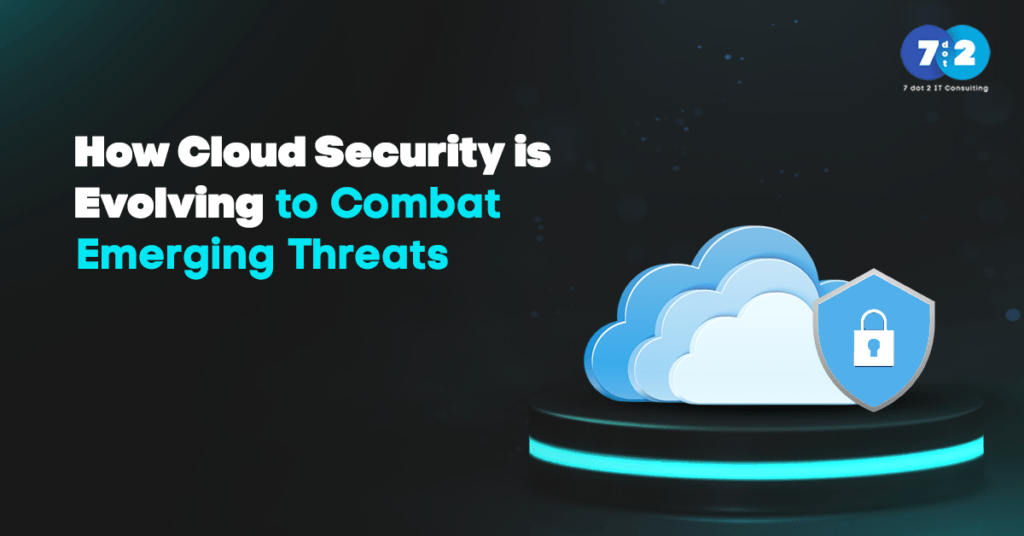How Is Cloud Security Evolving to Combat Emerging Threats?
Posted on : 16 November 2024 at 10:31 am, by Puneet Aggarwal, Founder 7 dot 2 IT Consulting

With organizations migrating to cloud environments, the threat surface is changing and so is the cybersecurity landscape. Such an evolution requires an ongoing process of securing data and trusting cloud services.
What Are the Biggest Cloud Security Threats?
The surge in the adoption of cloud computing created new vulnerabilities, some of which are mentioned below:
1) Service Account Exploitation: Attackers focus on over-privileged service accounts to move laterally in the cloud infrastructure which might lead to data breaches. We can mitigate this risk through the principle of least privilege and continuous monitoring.
2) Identity-Based Attacks: As cloud security becomes nestled around identity as a perimeter, new attacks such as credential theft and session hijacking have emerged. Deploying multi-factor authentication and embracing zero-trust models are effective countermeasures.
3) Cloud Data Base Vulnerabilities: One potential security risk associated with cloud databases is vulnerabilities that stem from misconfigurations or weak access controls resulting in unauthorized access to sensitive data. It is critical to segregate sensitive information through strict access controls and frequent patching to maintain security.
How Are Companies Strengthening Cloud Security?
As these threats have continued to evolve, so too have cloud security strategies:
- Zero Trust Architecture: Operating on the principles of “never trust always verify”, this model mandates continuous authentication and authorization for each user/device. By considering that threats can potentially be present inside the network as well as outside of it, the principle of zero trust addresses potential attack vectors.
- Artificial Intelligence and Machine Learning: AI & ML enable the detection and response of threats in real time. By using these technologies to analyze large swathes of data, organizations can highlight anomalies predict potential security incidents, and act on them.
- Continuous Monitoring and Threat Detection: Implementing tools that offer continuous monitoring can provide insights into network activities as they occur, enabling the prevention and detection of potential threats. Such threat intelligence feeds help predict and address new risks.
- SASE (Secure Access Service Edge): The combination of network security functions delivered as a service and a wide-area networking (WAN) capability. To make sure that the users can also access resources in a secure as well as efficient manner, irrespective of their location.
- Post Quantum Cryptography: With advancements in quantum computing, traditional encryption methods are at risk. Many renowned cloud-based companies are developing post-quantum cryptographic services to protect data against future quantum attacks.
Why Compliance is Critical for Cloud Security?
It is very crucial to abide by regulatory standards for cloud security such as:
- Regulatory Compliance: Organizations must adhere to regulations like GDPR, HIPAA, and CCPA to safeguard user data and avoid facing legal action. Ensuring Compliance by regular audits and assessments helps maintain compliance and highlight areas for enhancement.
- Data governance: These policies help define data access, storage, and sharing practices. This includes data labeling, encryption, and lifecycle governance to support data integrity and confidentiality.
- Third-Party Risk Management: Check whether vendors and partners meet security standards to prevent supply chain vulnerabilities, reducing the risk of breaches from external sources.
What is the Future Outlook of Cloud Computing?
As technology advances, cloud security will continue to evolve:
1) AI-Powered Security Operations: The use of artificial intelligence in security operations centers (SOCs) will improve threat detection and response times, enabling proactive measures to protect against attacks.
2) Decentralized Security Models: Utilizing blockchain technology provides decentralized security solutions that guarantee data integrity, security, and transparency without depending on central authority.
3) Improved Collaboration: Public-private partnerships and information-sharing initiatives will be crucial countermeasures against cyber threats, creating a collaborative defense against increasingly-present and sophisticated attacks.
Conclusion
Cloud security continues to evolve to combat new threats. Proactive models such as zero trust, AI-based threat detection, and 24/7 monitoring are a must for businesses to remain ahead of the curve. Regulatory compliance and robust governance frameworks will provide the required security. The cost of not protecting that security will only grow with the adoption and advancement of technology, and decentralized security models and strategic engagements among the public and private sectors will be essential to ending a future conversation against evolving cyber-attacks and threats. Those organizations that focus on cloud security now will have more sustainable, scalable, future-proofed digital infrastructures in the future.
Collaborating with 7 Dot 2 IT Consulting enables organizations to be proactive about cyber threats, providing advanced security measures.
